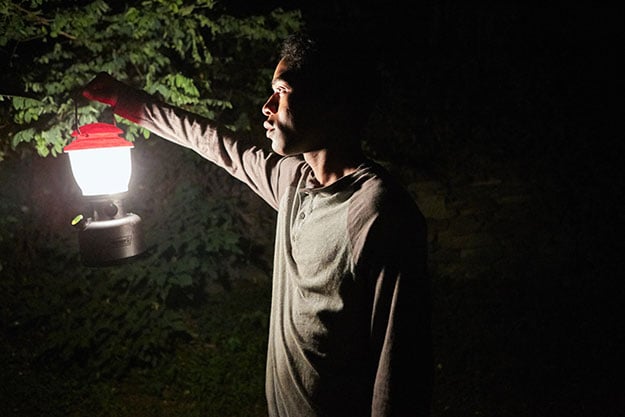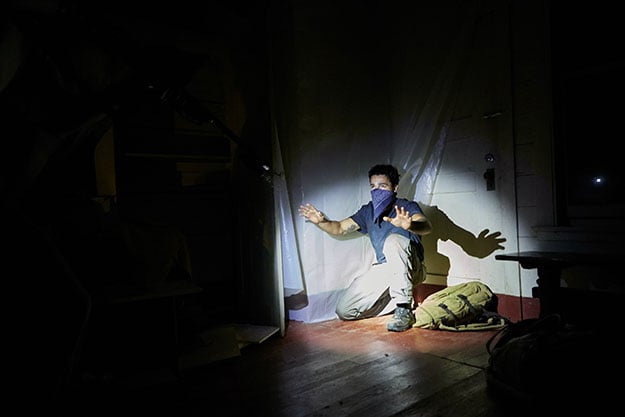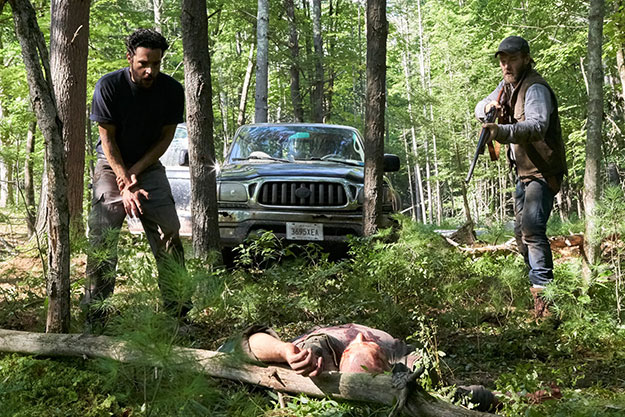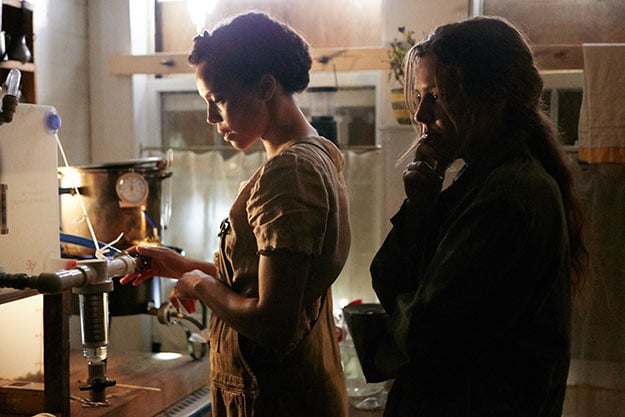Deep Focus: It Comes At Night

To change one letter from President Clinton’s famous line, this picture depends upon what the meaning of the word “it” is. Writer-director Trey Edward Shults has slapped a monster-movie title on a miniature horror film about the friction between two families under one roof during an apocalyptic plague. More than anything in the actual movie, the “it” in the title fuels our hope for a cathartic thrill or a tingling frisson. Combined with a dynamite trailer and a slew of generous reviews, that might be enough to draw opening weekend crowds. Once audiences get into theaters, is the movie substantial or entertaining enough to keep them there? It may depend upon their capacity for predictable morbidity. Shults fails to show us anything happening after dark that doesn’t also occur in the daytime.
In Shults’s first feature, Krisha (2015), he tried to transport us into what he called “the subjective delirium” of a recovering alcoholic reconnecting with her entire clan after a decade, on Thanksgiving. That film is a semi-transfixing shambles, anchored by a take-no-prisoners performance from Shults’s aunt, Krisha Fairchild. Audiences and critics cut it slack as an ambitious art-house debut. But It Comes at Night isn’t a character study or a dysfunctional family extravaganza. It’s an end-of-the-world genre film that makes you wish the end would come more quickly, as Shults attempts to extend his themes about family ties that are more like nooses. He wants to ask his viewers, “How far would you go to protect the people you love?” But his work is so clinical and devoid of revelation that it’s neither persuasive nor involving.
In the film’s opening scene, a man named Paul (Joel Edgerton), a woman named Sarah (Carmen Ejogo), and a teenage boy named Travis (Kelvin Harrison, Jr.) ease a disease-scarred old man (David Pendleton) off his sickbed and into a wheelbarrow, then accompany him to a shallow grave where he’s put out of his misery and incinerated. The casual presentation of this mixed-race family is laudable, but the actors evince so little shared feeling that I had no idea, at first, that they were really husband and wife, son and grandpa. (I thought they might be members of a cult.)

Why does Shults consider this a grabber of an opening? What does an introduction as bleak as this one suggest we can look forward to? All it sets in motion is a mundane form of dread. Are we meant to enjoy Shults’s newfound filmmaking finesse? Every “subtle” touch is driven home with a cinematic mallet, like the muffling of the sound or the oblique editing of the action or the lights flickering through floorboards or bouncing feebly off walls. After the first five minutes, I didn’t want any more ominous silences or impressionistic aural designs or matter-of-fact slaughters. I began to hope that “It” was a creature from outer space. No such luck.
Shults has said (in press notes) that It Comes at Night is full of personal riffs. The opening scene, for example, grew out of a deathbed reconciliation with his father. The print of Pieter Brueghel’s “Triumph of Death” that we see on Travis’s wall reflects Shults’s own obsession with Brueghel’s grotesque Armageddons, which he first saw hanging on his grandparents’ Texas walls, next to the firearms. While writing the script, Shults was also working for a survivalist relative who was piling up guns and canned goods. So far, so promising.
But the film lacks personality where it counts: the drama. Shults’s chiaroscuro effects are impressive, but his characters cast puny shadows. For the good of his family, Paul has become a control freak. His insistence on lecturing about the danger of making a single mistake—whether forgetting to grab a gas mask or leaving a door unlocked or going into the woods alone—grates on Travis. Sarah sympathizes with her son but always stands by her husband. Travis’s one source of unconditional love is his grandfather’s old dog. Try not to get attached to it.

The setup is as stark (but not as funny) as the “Trouble Brewing” cartoons in Gary Larson’s The Far Side. Will (Christopher Abbott), a former engineer (or mechanic, or contractor), breaks into Paul’s rural manse at night, thinking the darkened house is abandoned. He says he hopes to find provisions and shelter for his wife Kim (Riley Keough) and toddler Andrew (Griffin Robert Faulkner). Paul comes to believe him, after putting him through a brutal hazing, and Sarah suggests that it’s smarter to bring Will and family into their house than to worry about them lurking outside, especially since the newcomers possess precious goats and chickens. Once Will and Kim move in, Travis can’t take his eyes off them. They’re his parents’ opposites—loose, playful, and affectionate—and Andrew is a sweet tyke.
The contrasts couldn’t be more obvious. Paul is a former high school history teacher who is at home in the woods and faces crises with a rulebook. Will is a sociable urban character who may be telling white lies just to be ingratiating. Kim is a fetching young mother. Sarah is mostly a tense, drab, worn-out parent. Their scenes resemble exercises from a behavioral psychology lab. Will teaches Travis how to chop wood with a casual authority that the boy responds to immediately. Kim ignites Travis’s raging hormones, which become uncontrollable in his dreams.
Oh, yes, about those dreams. Travis has five or six of them, and they’re paralyzingly obvious. They’re chock-full of gotcha moments, accusatory images of the dead, and nightmares of the plague infecting everyone. Travis can’t fantasize about a bedmate without having her spew blood onto and into him. The dreams scarcely acquire the stature of those in, say, Hour of the Wolf, but once we catch on to Shults’s method, they do provide a modicum of suspense. We wonder when Travis’s dreamscape will merge with his waking nightmares.

As an audiovisual experience, the movie gets clogged up with self-conscious “art.” Just as John Alcott lit much of Barry Lyndon with candlelight, Shults’s cinematographer, Drew Daniels, lights scenes with campers’ lanterns. The house itself is an eccentric, brown-shingled beauty that juts into the woods. Its different sections connect squarely yet asymmetrically, and its long corridors and unexpected spaces allow Daniels’s camera to roam and pick out details, like the family pictures on a wall. (The estate is part of the Byrdcliffe arts colony near Woodstock, New York.)
Shults’s sensibility, though, is too ascetic to get the most out of this setting. We’re meant to sympathize with the vulnerable, openly emotional Travis, but Paul is the more substantial and catalytic character, and Shults rigs the situations so that Paul must perform spirit-killing acts. In a world where resources are limited, the plague is unstoppable, and any bit of dissembling can destroy trust, you understand why Paul might be all too ready to pick up his gun. At the end, he and Sarah can still sit around the kitchen table, but their universe is smaller.
Despite its attempt at churning up primal tension, this movie feels enervated and despondent about 21st-century life. It’s less a cry of pain than a paean to hopelessness.
Michael Sragow is a contributing editor to Film Comment and writes its Deep Focus column. He is a member of the National Society of Film Critics and the Los Angeles Film Critics Association. He also curates “The Moviegoer” at the Library of America website.







